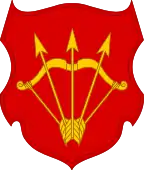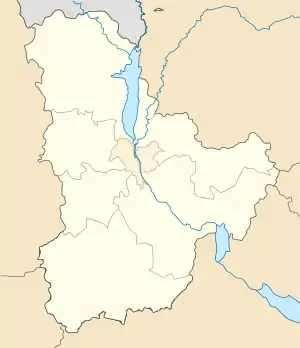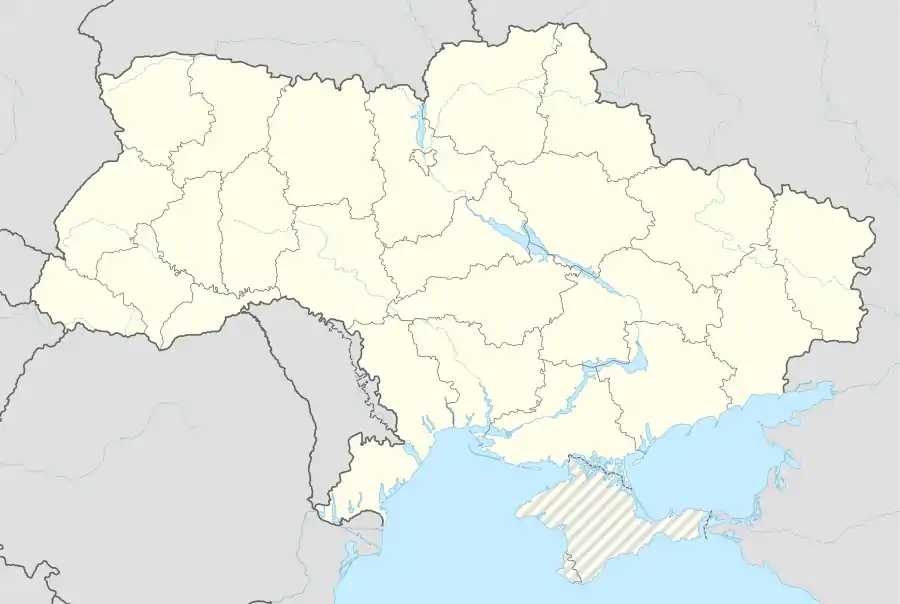Bila Tserkva
Bila Tserkva (Ukrainian: Бі́ла Це́рква [ˈbilɐ ˈtsɛrkwɐ]; Polish: Biała Cerkiew; Russian: Белая Церковь, tr. Belaya Tserkov [ˈbʲeləjə ˈtsɛrkəfʲ]; all lit. ''White Church'') is a city in central Ukraine, the largest city in Kyiv Oblast.[1] Bila Tserkva is located on the Ros River approximately 80 km (50 mi) south of Kyiv. The city has an area of 67.8 square kilometres (26.2 sq mi).[2] Its population is approximately 209,238 (2020 est.)[3] .
Bila Tserkva
Біла Церква | |
|---|---|
 Collage of the views of Bila Tserkva, Top left: A view of Ros River and Tsentralnyy Bridge, Top middle: Bila Tserkva National Agrarian University, Top right: The Heroes Hundreds of Heaven Street, Bottom upper left: Kurbas Market Mall, Bottom lower left: Colonnade Echo, Bottom right: Panoramic view of Bila Tserkva with Torhova Square | |
 Flag  Coat of arms | |
 Bila Tserkva Location of Bila Tserkva  Bila Tserkva Bila Tserkva (Ukraine) | |
| Coordinates: 49°47′56″N 30°06′55″E | |
| Country | |
| Oblast | |
| Raion | Bila Tserkva City Municipality |
| Founded | 1032 |
| Magdeburg Rights | 1589 |
| Government | |
| • Head of City Council | Gennadii Dykyi |
| Area | |
| • Total | 67.8 km2 (26.2 sq mi) |
| Elevation | 178 m (584 ft) |
| Population (2020) | |
| • Total | 209,238 |
| • Density | 3,100/km2 (8,000/sq mi) |
| Postal code | 09100-09117 |
| Area code(s) | (+380) 4563 |
| Vehicle registration | AI/10 |
| Sister cities | Barysaw, Jingzhou, Kaunas, Ostrowiec Świętokrzyski, Kremenchuk |
| Website | http://bc-rada.gov.ua/ |
Administratively, Bila Tserkva is a town of oblast significance. It also serves as the administrative center of Bila Tserkva Raion (district), though administratively it does not belong to the raion.
History
The town was founded in 1032 as Yuriiv by Yaroslav the Wise, whose Christian name was Yuri. The present name of the city, literally translated, is "White Church" and may refer to the (no longer existing) white-painted cathedral of medieval Yuriiv. From 1363 it belonged to the Grand Duchy of Lithuania, and from 1569 to the Polish–Lithuanian Commonwealth, administratively in the Powiat of Kyiv, part of Lesser Poland. It was crown property, but in recognition of his great service, it was granted to the Castellan of Kraków, Janusz Ostrogski. The next owner was Stanisław Lubomirski (1583–1649) and during his time the town was granted Magdeburg Rights by Sigismund III Vasa in 1620.
After subduing the rebellious Cossacks in the 1626 Battle of Bila Tserkva, the next owner of the estate was prince Jerzy Dymitr Wiśniowiecki. The castle was successfully taken by Bohdan Khmelnytsky in 1648. The Battle of Bila Tserkva (1651) led to the signing of a peace accord with the cossacks. The Treaty of Bila Tserkva between the Polish–Lithuanian Commonwealth and Ukrainian Cossack rebels under Bohdan Khmelnytsky was signed here in 1651.[4] In 1666, 6,000 Muscovite troops laid siege to Bila Tserkva. The standoff lasted until the following year when Polish reinforcements led by Jan Stachurski with the aid of allied cossacks and Iwan Brzuchowiecki smashed Petro Doroshenko's stranglehold.
The subsequent owner was Great Crown Hetman Stanislaw Jan Jabłonowski. In 1702, the castle was taken by the Cossack leader, Semen Paliy who made it his domain. In 1708, the town was overrun by prince Golitsyn's Russian army. The next owner of the town was Jan Stanislaw Jabłonowski, then Stanisław Wincenty Jabłonowski who erected a catholic church. After him ownership passed to Jerzy August Mniszech. The town was substantially refortified.

In 1774, Bila Tserkva (Biała Cerkiew), then the seat of the sub-prefecture (starostwo), came into the possession of Stanisław August Poniatowski who that same year granted the property to Franciszek Ksawery Branicki, Poland's Grand Hetman. He built there his urban residence – the Winter Palace complex and a country residence with the "Olexandria" park (named after his wife Aleksandra Branicka). He founded the Catholic church of John the Baptist and started construction of the Orthodox church, which was completed by his successor – his son, count Władysław Grzegorz Branicki. The latter also built the gymnasium-school complex in Bila Tserkva. Aleksander Branicki, the youngest grandson of the hetman, renovated and finished Mazepa's Orthodox church. Under the rule of count Władysław Michał Branicki, Bila Tserkva developed into a regional commercial and manufacturing centre.[5][6]
Bila Tserkva was annexed into the Russian Empire as a result of the Second Partition of Poland in 1793.
After 1861, the Czarist authorities converted the Roman Catholic church into an Orthodox Church.[7] During Soviet times, Bila Tserkva became a large industrial hub (machine building and construction industry).
During World War II, Bila Tserkva was occupied by the German Army from 16 July 1941 to 4 January 1944.[8] In August 1941 it was the site of the Bila Tserkva massacre.
During the Cold War, the town was host to the 72nd Guards Krasnograd Motor Rifle Division[9] and the 251st Instructor Heavy Bomber Aviation Regiment of Long Range Aviation.[10]
Geography
Bila Tserkva is located at 49°47'58.6" North, 30°06'32.9" East and is 178 metres (584 ft) above sea level. The city has a total area of 67.8 square kilometres (26.2 sq mi).
Demography
Up to the 20th century, the majority of the population of Bila Tserkva were Jews: by the end of the 19th century, 18,720 Jews lived in the city (52.9% of the city's total population).[11]
Evolution of Bila Tserkva's population (source: Ukrainian Wikipedia)
| 1926 | 1939 | 1959 | 1989 | 2001 | |
| Jews | 36.4 % | 19.6 % | 7.8 % | 2.0 % | 0.1 % |
| Russians | 3.4 % | 7.6 % | 18.6 % | 17.5 % | 10.3 % |
| Ukrainians | 57.0 % | 68.9 % | 71.0 % | 78.6 % | 87.4 % |
| Belarusians | 0.3 % | 1.0 % | 0.8 % | 0.6 % | |
| Poles | 2.4 % | 2.2 % | 0.2 % | 0.2 % | 0.1 % |
The destruction of the Jewish population, first by the Cossacks, Stalin's purges, and then during the Holocaust, partly as a result of the Bila Tserkva massacre, caused a major demographic shift and as a result, the city is now mostly inhabited by ethnic Ukrainians.
Infrastructure
Airports
Domestic transport and private flights provide services via Bila Tserkva Airport (UKBC), which is located southwest of the city in Hayok district.
Rail

Ukrzaliznytsia provides railway transit to surrounding areas in Kyiv Oblast and the rest of Ukraine.
There are two railway stations in Bila Tserkva:
- Bila Tserkva railway station
- Rotok railway station
Public transit
Bila Tserkva has six trolleybus lines.
Bridges
Bila Tserkva is the location of a few large bridges, two of which cross the Ros River.
Sights

A historical landscape park Arboretum Oleksandriya of 400 acres is situated in Bila Tserkva. It was founded in 1793 by the wife of Polish Hetman Franciszek Ksawery Branicki.
Notable buildings include the Merchant Court (1809–1814) and the Post Yard (1825–31).
There are also Palladian wooden buildings of the Branicki "Winter Palace" and the District Nobility Assembly (now it is gone because of a conflagration).
St. Nicholas Church was started in 1706 by Ukrainian Hetman Ivan Mazepa, but not completed until 1852.
The Orthodox Saviour's Transfiguration Cathedral was constructed in 1833–1839.
The Roman Catholic St. John the Baptist Church dates to 1812.
The St. Mary Magdalene Church was completed in 1846 by Count Branicki.
The building of the mid-19th century Great Choral Synagogue is preserved. Today it is the Technology and Economic College of Bila Tserkva National Agrarian University.
The Shukhov Water Tower, a tower that supports a water tank was built according to a project of Vladimir Shukhov, a Russian engineer-polymath, scientist and architect.
Education
Education in Bila Tserkva is provided by many private and public institutions. Bila Tserkva hosts several colleges and universities, including Bila Tserkva National Agrarian University.
Activities
2.jpg.webp)
The city is home to football team FC Ros Bila Tserkva. Ros is a team in the lower levels of the Football Federation of Ukraine: Kyiv Oblast Football Championship.
Industry in the city includes Railway Brake product manufacturers "Tribo Rail", Tribo plant and the major automobile tire manufacturer "Rosava".
The city is home to hockey club Bilyi Bars, that plays on Bilyi Bars Ice Arena, built by Kostyantyn Efymenko Charitable Foundation.
Notable people
- Eugene Deslaw – avant-garde French cinema director
- Luka Dolinski – Ukrainian painter, representative of the late Ukrainian Baroque, Rococo and Classicism, educated in Academy of Fine Arts Vienna
- Les Kurbas – Ukrainian movie and theater director, co-founder of Soviet theater avant-garde and a prominent figure of the Executed Renaissance
- Lyudmila Pavlichenko – World War II Soviet sniper. Credited with 309 kills, she is regarded as one of the top military snipers of all time and the most successful female sniper in history.
- David Bronstein – leading chess grandmaster and writer
- Volodymyr Dyudya – Ukrainian cyclist
- David Goodman, father of Benny Goodman – an American jazz and swing musician, clarinetist and bandleader; widely known as the "King of Swing"
- Halyna Nevinchana – Ukrainian painter, writer, journalist
- Ivan Nechuy-Levytsky – well-known Ukrainian writer, ethnographer, folklorist, teacher
- Andrzej Klimowicz – Zegota underground activist, Righteous Among the Nations
- Vadim Lazarkevich – Russian–Bulgarian illustrator
- Yuri Linnik – Soviet mathematician
- Olexandr Medvid' – famous Soviet/Belarusian wrestler.
- Pavlo Popovich – Ukrainian Soviet astronaut, 4th ever person in outer space, twice Hero of the Soviet Union
- Yossele Rosenblatt – renowned American cantor
- Shaye Shkarovsky – Yiddish author
- Sholem Aleichem – a leading Yiddish author and playwright, the Fiddler on the Roof musical is based on his stories
- Anna Ulitko – Danish natural scientist
- Lyudmila Usherovitz (Ayzenberg Married) – Jewish gymnast
- Shmuel Yerushalmi – Israeli protest poet
- Yevgen Potocki (Semenenko) – Ukrainian/Soviet rock-musician, 'Stranniki' (en. Wanderers) rock-band founder
- Yuriy Zagorodniy – footballer
- Yaroslav Koposov – Ukrainian musician
- Kostyantyn Efymenko – president of Biofarma, Chairman of Tribo ltd
Twin towns – sister cities
Gallery




 View of the so-called Ruins and the Laznevogo lake of the historical landscape park "Olexandria".[13]
View of the so-called Ruins and the Laznevogo lake of the historical landscape park "Olexandria".[13]

 The Roman Catholic St. John the Baptist Church AKA The Organ and Chamber Music Hall
The Roman Catholic St. John the Baptist Church AKA The Organ and Chamber Music Hall Temple of St. George
Temple of St. George Castle hill
Castle hill Railway station
Railway station
See also
References
- (after Kyiv which is the administrative center, but not part of the oblast)
- General information about the city, at Bila Tserkva official web-site
- "Чисельність наявного населення України (Actual population of Ukraine)" (PDF) (in Ukrainian). State Statistics Service of Ukraine. Retrieved 30 September 2020.
- Paul Robert Magocsi, A history of Ukraine, University of Toronto Press, 1996, p. 205
- E. A. Chernecki, L. P. Mordatenko, Bila Tserkva. Branicki family. Alexandria, Ogrody rezydencji magnackich XVIII-XIX wieku w Europie Środkowej i Wschodniej oraz problemy ich ochrony, Ośrodek Ochrony Zabytkowego Krajobrazu—Narodowa Instytucja Kultury, 2001, p.114
- Marek Ruszczyc, Dzieje rodu i fortuny Branickich, Delikon, 1991, p. 148
- Lucjan Blit, The origins of Polish socialism: the history and ideas of the first Polish Socialist Party 1878–1886, Cambridge University Press, 1971, p. 21
- "Onwar.com, Allies support resistance in Europe". Archived from the original on 22 May 2014. Retrieved 22 May 2014.
- Carey Schofield, Inside the Soviet Army, Headline Book Publishing, 2001, 132.
- Michael Holm, 251st Instructor Heavy Bomber Aviation Regiment, accessed December 2012.
- Архівована копія.
- "Miasta Partnerskie". Archived from the original on 2 May 2014. Retrieved 1 May 2014.
- For more images of the park "Olexandria", see klymenko.data-tec.net Archived 25 May 2006 at the Wayback Machine
External links
| Wikisource has the text of the 1911 Encyclopædia Britannica article Byelaya Tserkov. |
| Wikimedia Commons has media related to Bila Tserkva. |
- Fine and cheap hotel Kyiv in the center of our city
- Four stars hotel Kyiv in the center of our city
- Street Angels (UKRAINE) – Website of StreetRacers in Bila Tserkva
- Website of Bila Tserkva's patriots
- Informative Website of Bila Tserkva
- Old photos of Bila Tserkva
- Old photos of Alexandria park
- Official Bila Tserkva city webportal in Ukrainian
- Enterprise catalogue of Bila Tserkva
- Latest news in our city
- Sightseeings of Bila Tserkva
- History of Jewish Community in Belaya Tserkov
